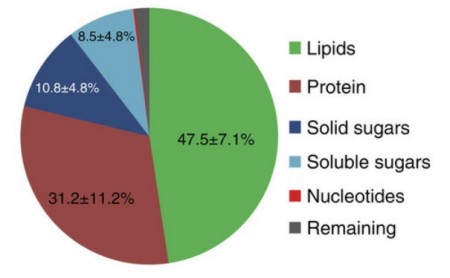Apr
5
A Major Algae Genome Sequence Complete
April 5, 2012 | 1 Comment
A Virginia Bioinformatics Institute (VBI) team has assembled the draft genome of Nannochloropis gaditana, a marine algae that may be capable of producing the lipid yields necessary for a viable fuel source. The overriding goal is to discover the best algae species for biodiesel production.
Researchers understand they must come up with a way to produce as much biofuel as possible in the smallest amount of space using the least amount of resources. Water is of particular concern – most cultivated crops need fresh water while some algae can use various water sources ranging from wastewater to brackish water and be grown in small, intensive plots on denuded land.
Robert Settlage, Ph.D. at VBI’s Data Analysis Core (DAC) explains, “Getting the data is now the easy part. What we’re doing in the DAC is enabling researchers to move beyond informatics issues of assembly and analysis to regain their focus on the biological implications of their research.”
The payoff is further analysis revealed that with fairly straightforward genetic modification, N. gaditana should be capable of producing biofuel on an industrial scale, which may be the wave of the future in fuel research and production.
Nannochloropis gaditana was selected because it comes from a strain family that’s attracted sustained interest from algal biofuels researchers owing to the high photoautotrophic biomass accumulation rates, high lipid content and the successful cultivation at large scale using natural sunlight in either open ponds or enclosed systems. There is already a long company list in research such as Solix Biofuels, Aurora Algae, Seambiotic, Hairong Electric Company/Seambiotic and Proviron.
Improvements in strain productivity have been stalled by the lack of a genetically tractable model system. That’s where VBI comes in. Nannochloropis could out produce the popular green alga Chlamydomonas reinhardtii and the diatom Phaeodactylum tricornutum, both of which have genome sequences and established transformation methods, but neither of these algae is a natively exceptional producer of biomass or lipids.
Nannochloropis gaditana has been successfully cultivated outdoors at commercial scale, is oleaginous and stores relatively large amounts of lipid, in the form of triacylglycerides, even during logarithmic growth. N. gaditana has high photoautotrophic biomass and lipid production rates and can grow to high densities while tolerating a wide range of conditions with regards to pH, temperature and salinity. These attributes make N. gadiyana a great candidate for development into a model organism for algal biofuel production.
It seems few people grasp the significance of the scale involved. Crude oil is being used at a rate in excess of 86 million barrels a day or 3,570,000.000 gallons. U.S. ethanol is closing in on one million barrels per day or 42 million gallons. The ratio is 3,750:42 (About 536:6 or 89:1).
Biofuels have a long way to go. The money is coming and the genome sequence for a top level candidate is in hand. It won’t be long until a super algae design makes news.
Let the genetic designer modification begin.
Comments
1 Comment so far



Today, in my opinion, understanding algal biology is the key to sucess for biofuels from algae as well as other valuable substances. I hope we see much more genomes sequenced along the next years…